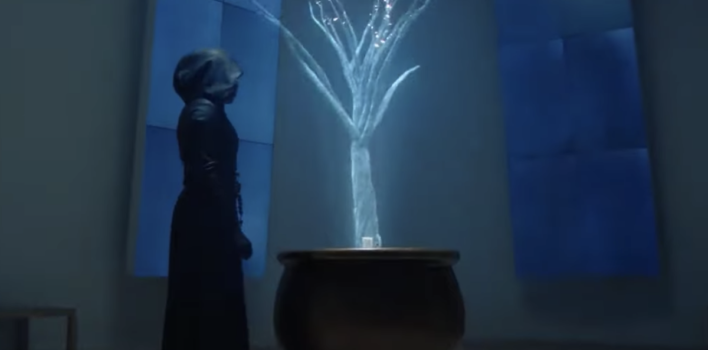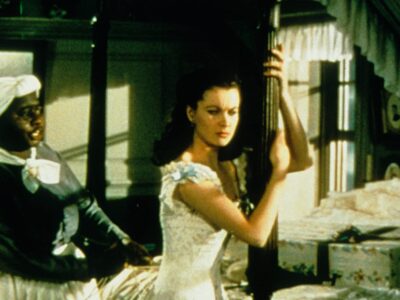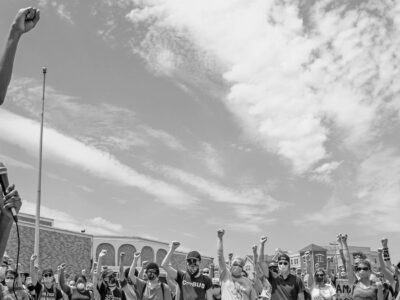Watchmen (2019): Midpoint Review
“If no one remembers a misdeed or names it publicly, it remains invisible. To the observer, its victim is not a victim and its perpetrator is not a perpetrator; both are misperceived because the suffering of the one and the violence of the other go unseen. A double injustice occurs—the first when the original deed is done and the second when it disappears.” – Miroslav Volf, The End of Memory (p. 29)
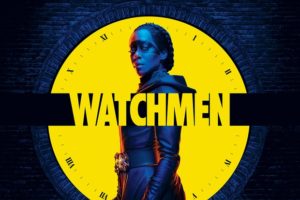 There is a moment at the end of the first episode of HBO’s Watchmen series where the Tulsa Chief of Police, Judd Crawford (played by Don Johnson), is lynched, his body hanging lifeless from a tree while Louis Gossett Jr.’s Will Reeves sits beside it in his wheelchair. A white man being lynched and a black man claiming to have done it: this is an intentionally fraught image that grips the viewer while simultaneously frustrating the imagistic frameworks in which Americans are usually introduced to from an early age. We are used to the image of black bodies hanging from trees with white men—often in the regalia of the Ku Klux Klan—standing beside them bearing the pride of a fresh kill, black people being no different from animals (certainly not people!) in their minds.
There is a moment at the end of the first episode of HBO’s Watchmen series where the Tulsa Chief of Police, Judd Crawford (played by Don Johnson), is lynched, his body hanging lifeless from a tree while Louis Gossett Jr.’s Will Reeves sits beside it in his wheelchair. A white man being lynched and a black man claiming to have done it: this is an intentionally fraught image that grips the viewer while simultaneously frustrating the imagistic frameworks in which Americans are usually introduced to from an early age. We are used to the image of black bodies hanging from trees with white men—often in the regalia of the Ku Klux Klan—standing beside them bearing the pride of a fresh kill, black people being no different from animals (certainly not people!) in their minds.
This scene comes at the end of an episode that begins with the only cinematic treatment of the 1921 Tulsa Race Massacre where a white mob entered “Black Wall Street”—the historic Greenwood District of Tulsa—and opened fire on men, women, and children before bombing their houses and buildings with flaming turpentine balls. Before this moment, Oklahoma had nearly become an “all-black state” which included African Americans and Native Americans in their number. Black colonization of the state was progressing until around 1910 when white colonists started moving into the state and fighting against the incorporation of Oklahoma into the country as an all-black state. Tulsa’s African American community had thrived, however, even in the midst of the slowly turning tides of white settlement and segregation. It had become a type of city on a hill for African Americans in the United States. However, 1921 brought many of these hopes and economic successes to an end as at least 300—a conservative estimate—African Americans died at the hands of the white mob and their business and neighborhoods were left charred. The mayor of Tulsa is currently, as I write this, attempting to investigate three potential mass graves where this domestic genocide took place.
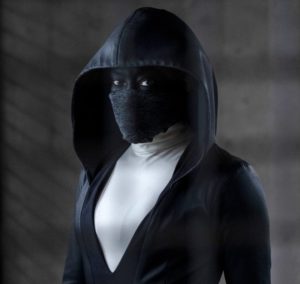 As a resident of Tulsa, opening a television show with an effective dramatic representation of a historical event that had literally been scrubbed from history books and clipped from newspapers and nearly forgotten locally, let alone nationally was a stark, but welcome, surprise. It is nice to partake in a mainstream cultural item that legitimizes something that has intentionally been kept from local and state history. Those survivors of the Race Massacre were systemically gaslighted by state and local officials until recently. There are still residents living in this city right now, both black and white, that do not know this event happened. It is a brave opening salvo to the viewing public. Paired with the final scene of the first episode, Watchmen has made it known that this will not be your typical history lesson.
As a resident of Tulsa, opening a television show with an effective dramatic representation of a historical event that had literally been scrubbed from history books and clipped from newspapers and nearly forgotten locally, let alone nationally was a stark, but welcome, surprise. It is nice to partake in a mainstream cultural item that legitimizes something that has intentionally been kept from local and state history. Those survivors of the Race Massacre were systemically gaslighted by state and local officials until recently. There are still residents living in this city right now, both black and white, that do not know this event happened. It is a brave opening salvo to the viewing public. Paired with the final scene of the first episode, Watchmen has made it known that this will not be your typical history lesson.
At the time of this article’s writing, we are five episodes into the first season of the show. We have been introduced to our key characters thus far: Sister Night (Regina King), Looking Glass (Tim Blake Nelson), Laurie Blake (Jean Smart), Adrien Veidt (Jeremy Irons), Will Reeves (Louis Gossett Jr.), and Lady Trieu (Hong Chau). Veidt remains isolated from the rest of the characters as his storyline seems almost like an intermission of sorts from the driving narrative taking place in an alternate imagining of Tulsa, Oklahoma in 2019. The stories seem to be veering into each other and it is a safe assumption that there will be a full-on collision before the end of the season.
Where we currently stand, the Tulsa police force incorporates vigilantes—“superheroes”—and masked officers in order to maintain the anonymity of the officers in order to “protect” them from reprisal. This force, which includes Sister Night, Looking Glass, and eventually Laurie Blake as its new chief after the events of the first episode, is attempting to sniff out the location of the Seventh Kavalry, an amalgam of the original graphic novel’s Rorschach character and white supremacist ideology, in order to stop whatever their designs are for the city. Sister Night finds out that her genealogy is 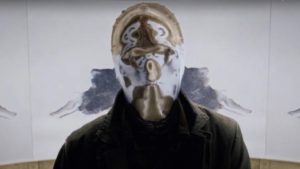 directly tied to a survivor of the Tulsa Race Massacre of ’21, Will Reeves. He is her grandfather, but she remains reticent to trust him and understandably so as we see his connection to Lady Trieu who bought Veidt Enterprises after the news of Adrien Veidt’s death. At the same time, Looking Glass is lured to the warehouse of the Seventh Kavalry where they are building a teleportation portal and his sense of reality and truth is upset when they introduce him to the video of Veidt addressing President Redford right before his attack on New York in 1985—from the original graphic novel and represented at the beginning of episode five where we learn the origin of Looking Glass’ PTSD. Not knowing what to do with the information given to him by the Seventh Kavalry or who to believe at this point, he does not dissuade Sister Night from revealing that her grandfather was behind the death of Judd Crawford. We are left with Sister Night being held at gunpoint by Laurie Blake after overhearing the confession over a bug on Looking Glass’ desk.
directly tied to a survivor of the Tulsa Race Massacre of ’21, Will Reeves. He is her grandfather, but she remains reticent to trust him and understandably so as we see his connection to Lady Trieu who bought Veidt Enterprises after the news of Adrien Veidt’s death. At the same time, Looking Glass is lured to the warehouse of the Seventh Kavalry where they are building a teleportation portal and his sense of reality and truth is upset when they introduce him to the video of Veidt addressing President Redford right before his attack on New York in 1985—from the original graphic novel and represented at the beginning of episode five where we learn the origin of Looking Glass’ PTSD. Not knowing what to do with the information given to him by the Seventh Kavalry or who to believe at this point, he does not dissuade Sister Night from revealing that her grandfather was behind the death of Judd Crawford. We are left with Sister Night being held at gunpoint by Laurie Blake after overhearing the confession over a bug on Looking Glass’ desk.
Meanwhile, Adrien Veidt remains in another land where he lives with a male and female servant who turn out to have multitudes of clones; which he kills with abandon and then catapults into the sky where they disappear on the surface of Europa. He creates a suit that protects him from the environs of Europa and his servants catapult him into the sky (through the portal) to land on the surface of Europa, and begins to pile the bodies into words on the surface spelling “SAVE ME.”
There are numerous strands that complicate these central stories as well throughout the first five episodes, and how each of these strands will be weaved together by the conclusion is yet to be seen. The complexities of the stories are compelling and constantly maneuvering on a tightrope, narrowly avoiding utter implosion with rich imagery and offsetting cultural/social/political reversals. Yet with all of its complexities, the concept of race is very much at the forefront of this series’ concerns. As someone who sees, on a daily basis, how Tulsa’s history physically impacts the black community of the city, how Greenwood and other districts of Tulsa are becoming increasingly gentrified, and how white colonization has only become more insidious, this alternate Tulsa is perhaps the blunter, easier version of the reality the city inhabits now. All of the racism, bigotry, and violence is out in plain sight in the world of Watchmen instead of hiding behind community development projects, economic growth, and the continual insistence that we live in a post-racial society.
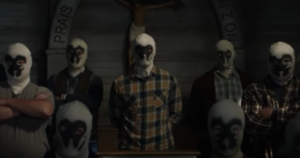 Yet to its credit, Watchmen is attempting to contend with how we remember the original sin of our city, our state, and our country and what actual truth looks like. It contends with the history of the genocide of native peoples and the forced labor and dehumanization of African peoples. These are events that are remembered in a certain way so as not to actually confront the benefits white Americans have gained from their ancestors’—and to varying extents their own—actions towards minorities throughout this country’s history, while other events like 9/11 are placed front and center as an acceptable national memory in order to instill in the populace justifications for our foreign and domestic policies and wars. What is truth? Who holds that truth? Who wields it as a weapon? These are at the thematic center of the show. It certainly seems like the truth will shift the paradigms of our central characters and shake them to their core. They will be forced to live differently in the midst of the truth’s light…and heat. We will as well. The victim and the perpetrator will be seen and will be known.
Yet to its credit, Watchmen is attempting to contend with how we remember the original sin of our city, our state, and our country and what actual truth looks like. It contends with the history of the genocide of native peoples and the forced labor and dehumanization of African peoples. These are events that are remembered in a certain way so as not to actually confront the benefits white Americans have gained from their ancestors’—and to varying extents their own—actions towards minorities throughout this country’s history, while other events like 9/11 are placed front and center as an acceptable national memory in order to instill in the populace justifications for our foreign and domestic policies and wars. What is truth? Who holds that truth? Who wields it as a weapon? These are at the thematic center of the show. It certainly seems like the truth will shift the paradigms of our central characters and shake them to their core. They will be forced to live differently in the midst of the truth’s light…and heat. We will as well. The victim and the perpetrator will be seen and will be known.


